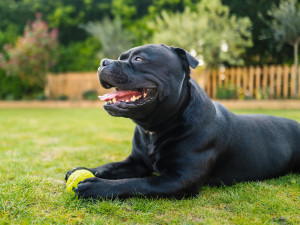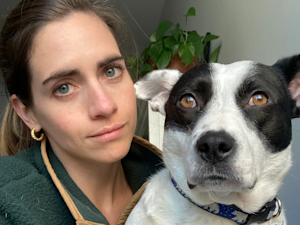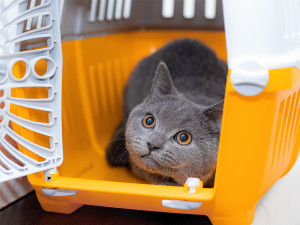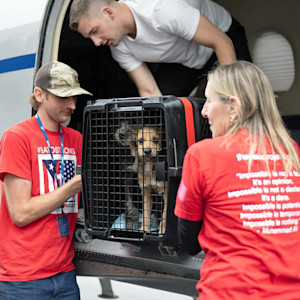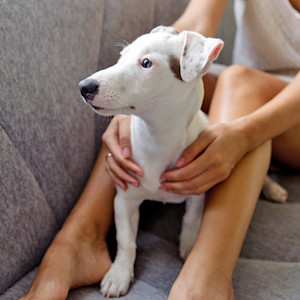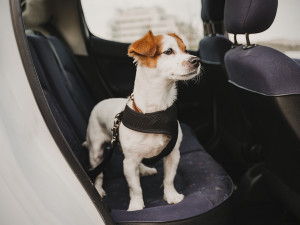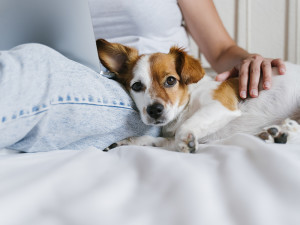It’s Wildfire Season—Here’s How You Can Keep Your Dog (Literally) Breathing Easy
If you wouldn’t exercise outside with all that smoke, then your dog shouldn’t, either.
Last year, a hazy orange-gray smoke transformed New York City into an apocalyptic versionopens in new tab of itself. The perpetrator? Record-breaking wildfires in Canada, several hundreds of miles away.
As wildfire season starts earlier and lasts longeropens in new tab, it poses a double threat: There’s the imminent risk of fire, requiring evacuations and causing some to lose their homes or even lives. However, there’s also the risk of poor air quality and respiratory issues due to wildfire smoke that blows over large swaths of the country. Already this year, wildfires across the western U.S. and Canada have sparked widespreadopens in new tab air-quality alertsopens in new tab.
Snap a pic of your pup’s teeth, and GREENIES™ will help you spot potential signs of oral health issues.
We spoke with Dr. Jessica Bell, a veterinarian and associate clinical professor of community practice, at Washington State University’s Veterinary Teaching Hospital. She told us all about pet respiratory health and how to keep your dog safe from secondhand smoke during wildfire season.
How do I know if the air is safe for my dog?
According to Dr. Bell, if the air is safe for you, it’s safe for your dog. The opposite also holds true.
How much do you spend on your pet per year?
“If the air quality is so bad that you shouldn't be out breathing it going for a walk, then your dog shouldn't be either,” she says.
If you’re not sure whether or not it’s safe to venture outside, the Environmental Protection Agency’s Air Quality Indexopens in new tab (AQI) can tell you the daily air quality in your area. The AQI categorizes air quality along a scale of 0 to 500, with higher values representing higher levels of air pollution and more severe health concerns.
AQI 0-50: Good air quality conditions
AQI 51-100: Moderate air quality conditions
AQI 101-150: Unhealthy air quality for sensitive groups
AQI 151-200: Unhealthy air quality
AQI 201-300: Very unhealthy air quality
AQI 301-500: Hazardous air quality
You can determine the AQI in your area on weather apps and websites such as AirNow.gov.opens in new tab
Pet parents with brachycephalic dog breeds, or short-face dogs like Bulldogs and Boxers, as well as dogs with pre-existing respiratory issues should be extra cautious about air quality. Working dogs, who spend long periods outside with heavy exercise — such as cattle dogs or police dogs — should also be monitored carefully if air quality is poor.
How to keep your pets safe during smoky periods
Bell says it’s important to remember that wildfire smoke is a temporary challenge. You can keep your pet safe with a few short-term adjustments to your daily routine while you wait for the skies to clear.
For mildly smoky conditions, keep an eye on the weather, air currents, and air quality at different times of day. If the air quality is better in the early morning or late evening, schedule your walks for those times.
If the air quality in your area is becomes unhealthy, avoid taking your dog outside for walks or heavy exercise and keep outdoor time to bathroom breaks.
“Short little bursts: no exercise after, go to the bathroom, back in,” Bell says. “That’s fine.”
You can take extra precautions by keeping all windows and doors closed and running the AC, ideally with air filters. If you live in an area that’s frequently impacted by wildfire smoke, you might also consider purchasing air purifiers for your home.
How to keep your dog entertained on “smoke days”
If the forecast indicates that you may need to skip walks and keep your dog indoors for consecutive days, you might want to find some activities to keep your dog from going too stir-crazy.
Consider brushing up on some training or teaching your dog new tricks. You can also use a Kong or other interactive puzzle toys to keep your dog entertained and mentally stimulated during mealtimes.
What to do if your dog inhales too much smoke
If you’re worried that your dog has inhaled too much wildfire smoke, keep an eye out for persistent symptoms that indicate your dog needs urgent veterinary attention.
“If there’s continued respiratory distress or labored breathing at rest, or there's coughing involved, or they're uncomfortable, not eating, getting lethargic — then they definitely need to be seen by a veterinarian,” Bell adds.
Look for common symptoms of respiratory irritation, such as:
Asthma-type symptoms, increased breathing rate, noisier breathing
Coughing or gagging
Eye irritation and excessive watering
Nasal discharge
Fatigue or weakness
Disorientation or stumbling
Reduced appetite and/or thirst
Safety over smoke-inhalation risk
It might be tough for you and your dog to skip walks and bunker down inside, especially during the warm summer months that coincide with wildfire season.
However, the silver lining around wildfires is that they eventually pass: After just a few days of precautions, you should be able to return to your normal routine and rest easy knowing you kept your dog safe and healthy.





